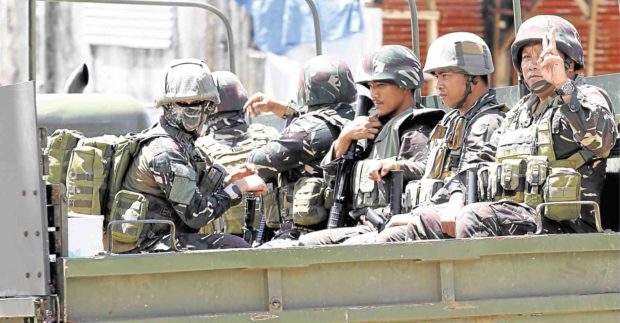The landscape of Marawi City had been drastically altered by the continuing war on terror which needed more soldiers (top photo) than had been earlier projected. —JEOFFREY MAITEM
MARAWI CITY — Up to 61 persons were still missing here as government forces continued operations to rescue civilians still trapped in the fighting between soldiers and homegrown Islamic State (IS) followers trying to set up an IS province in this predominantly Muslim city.
Zia Alonto Adiong, spokesperson of the Lanao del Sur Crisis Management Committee (CMC), said authorities based their estimate on the number of missing persons on reports given by the police’s Scene of the Crime Operation (Soco) personnel.
Adiong said residents searching for relatives had been going to the CMC and given DNA samples (hair, tissue, saliva, etc) hoping to locate their loved ones. These DNA samples were being matched with those of bodies recovered in the battle zone or rescued hostages.
Based on the number of requests for DNA matching, the number of still missing persons had reached 61, Adiong said.
Military estimate
The number matches the military’s own estimate that between 40-60 hostages are still in the battle zone.
Col. Romeo Brawner Jr., deputy commander of the Joint Task Force Ranao, said the latest estimate on the number of hostages was drawn from information provided by those who had been rescued—including 17 hostages who managed to escape and were intercepted by soldiers on Wednesday last week.
He said since the fighting had started, the total number of rescued civilians had already reached 1,750.
Fatima Lumabao, an evacuee, said she was hoping that her four missing children—Norhuda, 21; Rasida, 20; Parhana, 12 and Mohammad, 10—were among the civilians still being held captive by the terrorists.
Lumabao’s four children disappeared amid the chaos that followed the rampage in Marawi City by Maute and Abu Sayyaf terrorists on May 23. Her search continued to be unfruitful for nearly five months now.
“I have asked everyone. I have inquired from the military each time news of hostages escaping reached me, but no positive development,” she told the Inquirer.
Decent burial
But she admitted that sometimes she could not avoid thinking her children had been killed in the fighting.
“Even if the thought is depressing, I have to accept it. If they had died, I want their bodies found so I can give them a decent burial,” Lumabao added.
Most of the recovered remains—including those that have been buried at the Maqbarah cemetery here—had not been identified but authorities believed they belonged to slain terrorists.
Since the start of the fighting, 117 remains had already been recovered and DNA samples had been collected from them before they were buried.
Lumabao’s DNA samples did not match any of those from recovered bodies which gives her hope. “But where are my children?” she said. —Allan Nawal
